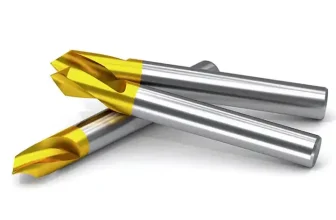Many people do not even consider the RPM they use to drill, but selecting the best RPM for drilling can be one of the more important variables depending on the material being drilled.
RPM is especially important when drilling harder metals such as stainless steel. Even with the best drill bits for stainless steel the RPM is very important. Other, softer, materials are more forgiving with respect to drilling RPM.
Surface Feet Per Minute (SFM)
You will likely see material drilling speeds listed in surface feet per minute. When it comes to drill bits, surface feet per minute is calculated using the bit circumference and the RPM of the drill.
The formula for calculating SFM is:
SFM = RPM x bit-diameter x .2616
Let’s give a quick example for a 1/2″ bit at 1,500 RPM.
So, we plug the numbers into the formula above, and we get the following:
SFM = 1500 x 0.500 x .2616
When we calculate the SFM we come up with 196.2 surface feet per minute.
We Usually Need RPM
That’s all well and good, but you will likely already have a SFM target value you are looking to hit with a certain diameter bit. In this case you will need to calculate the correct RPM to get the SFM you need for the size of bit you are using.
Using a little algebra, we come up with the following formula to solve the SFM formula above for RPM.
RPM = SFM x 3.8196 / diameter
Let’s plug in our numbers from the SFM example above to make sure we get the correct answer.
RPM = 196.2 x 3.8196 / 0.500
When we solve for these vales we get about 1,500 RPM, which is what we expect. The number is not exactly 1,500 due to the rounding of some of the formula values. Using this formula we can now take a target SFM value and a bit diameter and get the RPM we need to run at to achieve that SFM speed.
Bit Material
In the following examples we are going to assume a high speed steel (HSS) bit.
If you have metal drill bits already this is likely what you have as they are the most common general metal bits you will encounter. Harder bits, such as carbide bits, can handle a higher SFM speed than HSS bits.
For carbide you can expect to increase the SFM 2 times or more over a HSS bit.
Think of These as Speed Limits
These SFM values should be considered speed limits and not the RPM that you must use. You can run a lower SFM speed without any problems. Running a lower speed just means drilling will take longer, but it will not adversely affect the bit.
Cutting Fluid
Another thing to keep in mind is that using cutting fluid will allow an increase in the SFM value as well. You will also get a better quality cut, and some kind of cutting fluid should be used when cutting steel anyway.
Wood and Plastic
If you are drilling a soft material such as wood or plastic you can run a higher SFM value. Just to give an example, a common SFM range recommendation for wood would be something like 300 SFM.
Let’s say you want to drill a 1/4″ hole in some regular wood, something like a standard 2×4. We know how to solve this from our example above. We just plug in the SFM and bit diameter, and we can find the maximum RPM we should be running at.
RPM = 300 x 3.8196 / 0.25
Solving the formula with these values gives us a maximum RPM of around 4,583 for this setup. This is pretty fast and is more than many drills can achieve. But that’s ok, remember this is only the maximum speed, you can run at a lower speed without any issues.
Soft Metals
Soft metals would include things like standard brass, bronze, and aluminum. A good rule of thumb for these soft metals would be around 200 SFM.
Let’s use the same size bit we used for the wood example, a 1/4″ high speed steel (HSS) one. Just like before, we can plug in the numbers to get the maximum RPM we should be using.
RPM = 200 x 3.8196 / 0.25
Solving for these values we get a maximum RPM of around 3,055.
Hard Metals
Moving up to some harder metals we require a slower SFM cutting speed. In this example let’s take a look at 304 stainless steel.
This is the most common alloy of stainless steel out there, so if you will be doing any stainless drilling you will likely encounter 304.
We will take our same example as above, using a 1/4″ high speed steel (HHS) bit. A good starting value for SFM for 304 stainless steel is 45 SFM.
You can see that as we move up to harder and harder materials the SFM value get lower and lower.
In this example we will use the same 1/4″ high speed steel (HSS) drill bit. Just as we have done previously, let’s plug the numbers into our formula.
RPM = 45 x 3.8196 / 0.25
Using our tried and true formula for drilling a 1/4″ hole in 304 stainless we get a maximum RPM of around 687 for this setup.
Bit Size Effect
As you might have already guess by looking at our RPM formula, the larger the bit used the lower the maximum RPM. There is a direct relationship between the bit size and the RPM.
Let’s take a look at an example. We will use our last calculation for 304 stainless steel. Here is our 1/4″ drill bit example above again.
RPM = 45 x 3.8196 / 0.25
As we already know, this comes out to a maximum RPM of around 687.
Let’s see how a larger drill bit affects the RPM, we will do our calculation with a 1/2″ high speed steel (HSS) bit instead of the 1/4″ one.
Now the equation becomes:
RPM = 45 x 3.8196 / 0.500
If we solve this equation we get a maximum RPM of around 343. You will notice that doubling the bit size from 1/4″ to 1/2″ halves the maximum RPM. This makes sense since the twice as large bit will have twice the diameter.
With each revolution the larger bit’s surface feet per minute (SFM) will double, so we have to halve the RPM to compensate.
Conclusion
The SFM values here just some general examples to give you an idea of how to calculate your own RPM targets. It is best to start on the slower side and then move up in speed if possible to optimize for your specific application.
You should consult the manufacturer of the bits you are using to get more accurate recommendations for the SFM values you should be using for your application. They will know the exact parameters for their bits and be able to give you the data you need to perform more exact calculations.
Happy Drilling!







